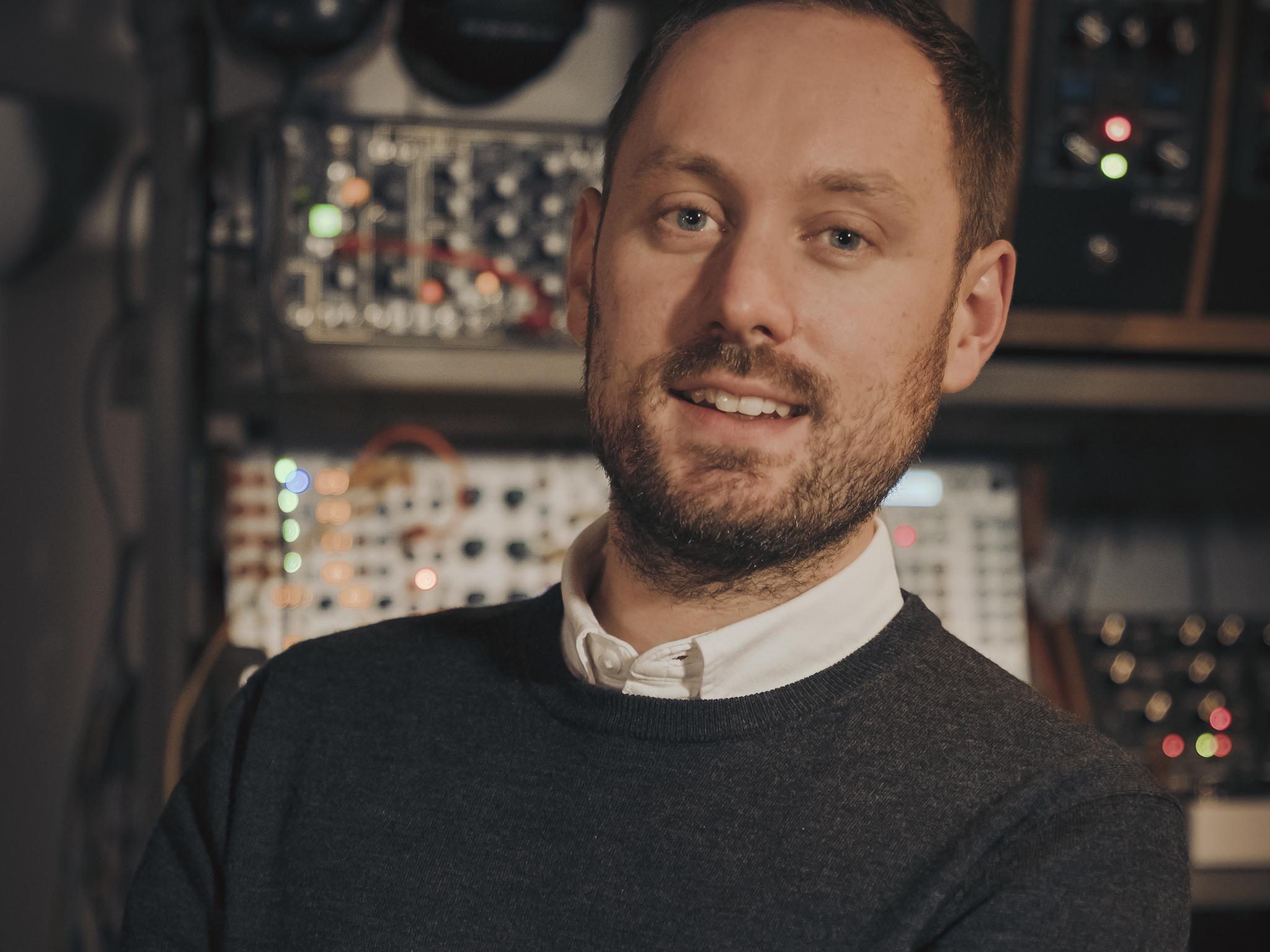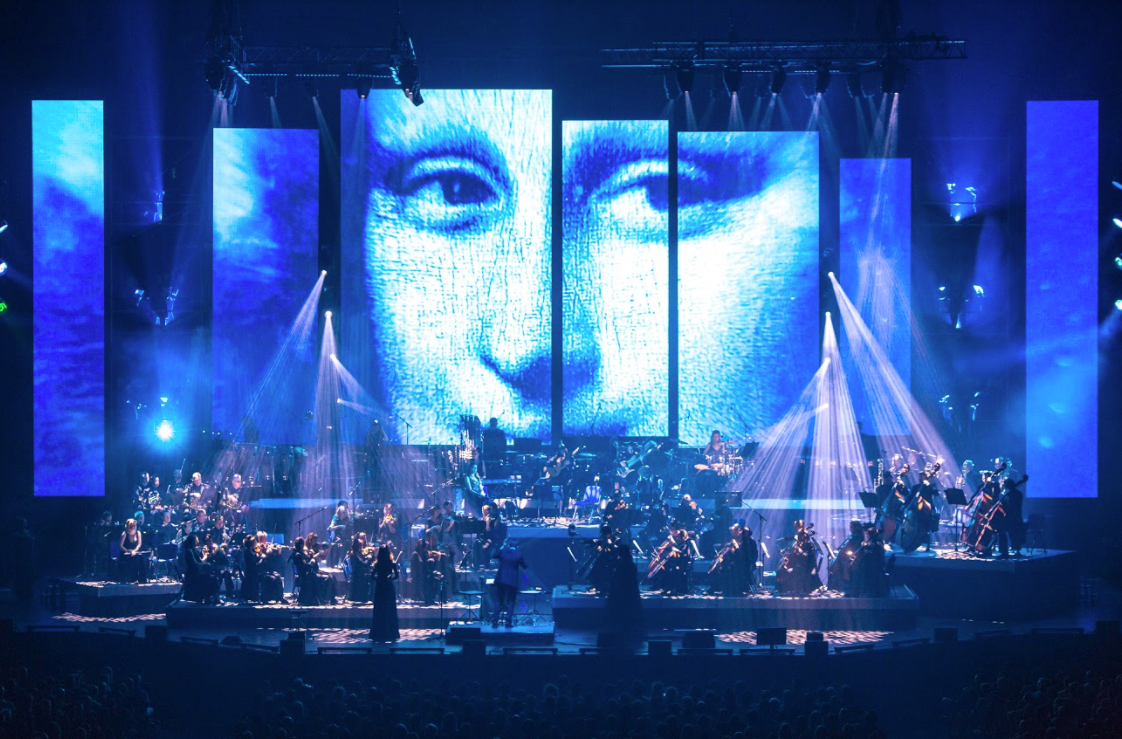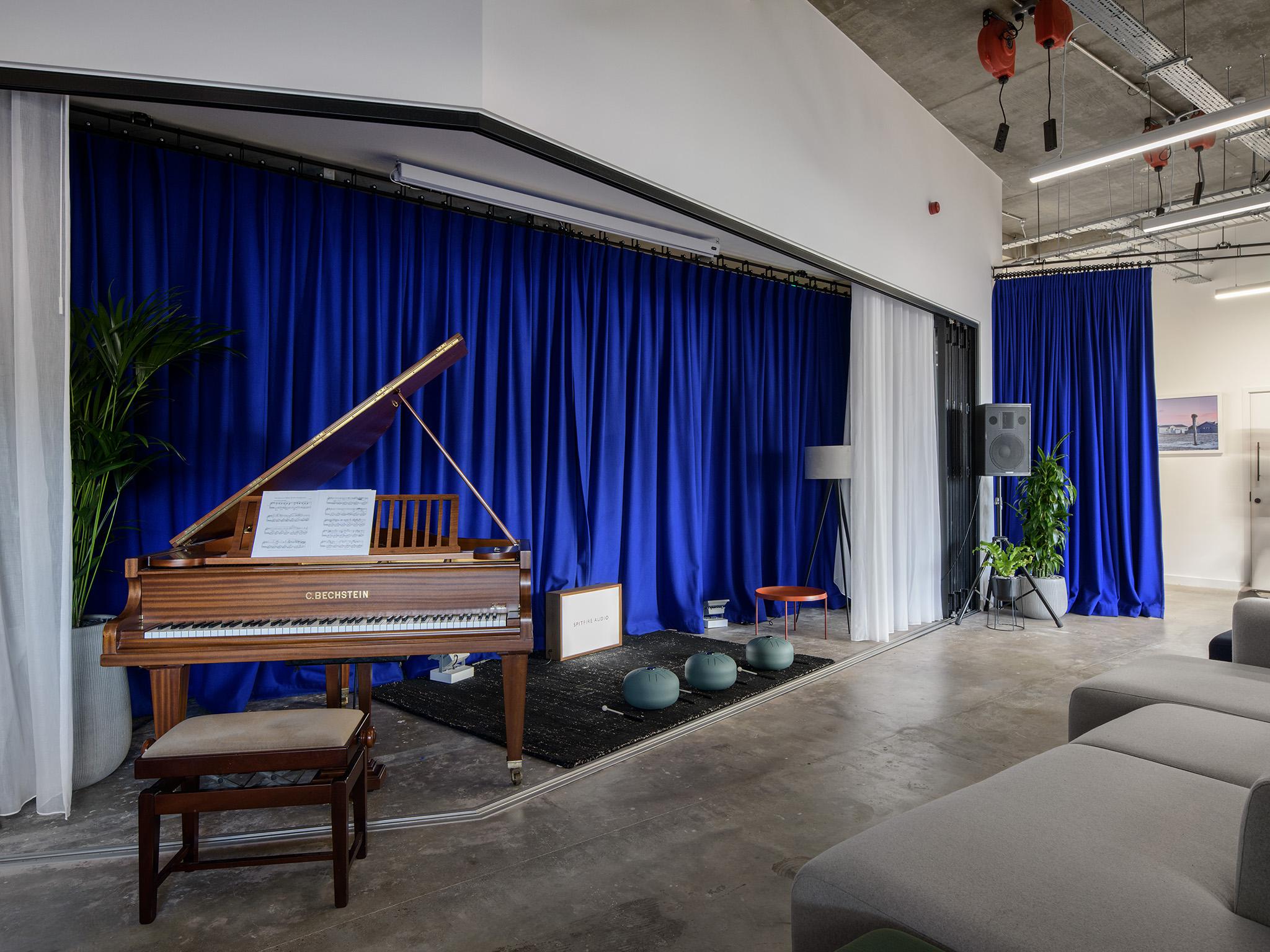Orchestral manoeuverers: Tech-savvy musicians whose virtual instruments mean ‘anyone can be a composer’
Can’t afford a 109-piece ensemble to help compose and perform your latest work? Fear not – a sample library around the corner from Kings Cross has all the cleaned and polished notes you’ll ever need. Andy Martin pays a visit to Spitfire Audio, creators of ‘impossible sounds’


Film composers Paul Thomson and Christian Henson had just been thrown out of an online music forum. They had been making disparaging remarks about another contemporary composer. Deemed to be bad form. They took refuge in the Endurance pub in Soho (which is no longer there) and compared notes. Quite literally. They agreed it had to be possible to come up with better notes. Of the musical kind. All the existing notes – the ones that had been sampled and stored in assorted electronic artefacts – were, they thought, rubbish.
Out of that alcohol-infused lament, back in 2007, Spitfire Audio was born. The name was the result of Henson living next door to the Imperial War Museum, which boasted a Spitfire soaring through the foyer. The word struck a Battle-of-Britain chord in their filmic imaginations. Their heroic mission was simple, obvious, and yet had never been tried before. If you were going to sample notes and make them available to composers in digital form, then you had to get good musicians and put them in a decent studio with serious microphones, and record them properly, note by note, instrument by instrument. The main drawback was the cost. Which was huge.
As with all good music, timing was crucial. As it happened, Henson had recently racked up massive royalties, all thanks to a jingle – let’s call it a very short soundtrack – for a television commercial that had taken off in Germany. They took that money and shelled out for a full-on orchestra for a couple of days in the Air studios in London (cost: around a quarter of a million). It was a “leap of faith”, as Thomson says. “We put a bottle of champagne under the chair of each of the musicians – to create the right mood.” They ended up with a small, private collection of exquisite sounds. But they soon attracted the attention of a handful of leading composers, including Hans Zimmer (who scored The Dark Knight, Interstellar, Inception among a hundred other films and is now head of music at DreamWorks). Before they’d even finished their first “library”, it was already being used to produce the soundtrack to The Chronicles of Narnia.
Now Spitfire Audio has moved into a new, bespoke three-storey building in the Tileyard music campus, near King’s Cross in London, surrounded by other studios like Prodigy and Platoon, amid the likes of Lily Allen and Mark Ronson. They have turned the tide in the battle against the bad recordings of old. Appropriately enough, Dunkirk used Spitfire. Their “tools” have built the complex soundscapes of such films as Avatar and they provided the “tidal orchestra” for Blue Planet. I was taken on a magical mystery tour around Spitfire. It’s like an Aladdin’s cave in there, bursting with classic instruments and cutting-edge tech for recording and composing, a Bechstein, a Moog, and a lot of curved screens. But one thing I really liked: a bunch of four Post-its stuck to the wall of one of its many multi-purpose rooms, spelling out, Think of something brilliant.
You’re probably thinking: well, how many notes are there exactly? In The Sound of Music, “Do-Re-Mi”, it’s seven. Schoenberg used 12, didn’t he? Add up all of the chromatic scale (A to G with flats and sharps in between), plus a few more for non-western tonalities: how long can it take to record them all? The surprising answer is: there is no such thing as a “note”, any more than there is a circle, a triangle, or a straight line. It exists only in theory or on the page, not in your ear. Middle C, for example, is only an ideal, a mathematical form or template. In acoustic reality, there are potentially infinite renditions or performances of any single note. Not only does that note depend on which instrument it is being played on (violin, xylophone, tuba), it can vary according to the mood of the musician (is she suffering from a broken heart? Did his cat die recently? Was there a bottle of champagne under the chair?), but above all varies with articulation and dynamic. Is it bowed or plucked? Staccato or legato? Rounded and noble, or jagged and harsh? Music is perhaps the primal language, and a C-sharp sounds different according to who is pronouncing it, when, where, and why.
Will Evans, the CEO of Spitfire, shows me around. He is an acoustician who used to lecture on electroacoustics at the University of Surrey, in Guildford, and is the proud owner of a Nakamichi 600 cassette deck, dating from the late Sixties. Many Spitfire employees are graduates of his “Tonmeister” course. He has a relaxed approach to the work ethic. “I don’t really do business here,” he says. “I come in because I like to listen to music all day long. People shouldn’t be working here – this is more of a hangout space.”
Spitfire is not exactly a music factory. What they produce is only spare parts and accessories: a toolbox or a palette of sounds. What you put on the canvas is up to you. Spitfire is to music what Cern is to matter: the point is to break sound down into its ultimate, irreducible particles. And then collide them. The emphasis is on purity. “It’s all about perfecting the sound,” Evans says. To start with you need a forest of microphones to pick up the sounds (the C12, originally developed in the 1950s, is still rated at the top of the tree). The next step is to clean up the recordings.

Up on the third floor, the engine room of product development, I watch a note being cleaned and polished. Otherwise known as “de-noising” – removing all the random clicks and pops and coughs and ambient sounds. The interesting thing is that a note can be represented graphically on a screen, visualised so that you can actually see the interference. I watch as fresh-faced young Spitfire tonmeisters rub out all the inessential sounds, using a piece of software called “RX6 Advanced”, like using an eraser on a rough drawing, to engineer a smooth, elegant geometry. They’re all musicians too, composers or performers in their own right, but like 99 per cent of all contemporary musicians, they’re also tech-savvy.
It was hard not to be awed by the fusion of art and science. But I had to express a certain anxiety: weren’t they, in effect, sawing off the branch on which they were sitting? Or, to put it less poetically, weren’t they killing musicians? Warner Bros recently signed an algorithm called Endel to their label. Not an “artist” just a piece of code. There will be no more tossing of televisions out of hotel windows, no more drug-fuelled partying, only endless albums of soothing mood music. Wasn’t Spitfire doing something comparable? I saw its audio library as a potential Terminator among live musicians. If you can have an orchestra of “virtual instruments” on your laptop, why bother with the real thing any more?

Paul Thomson, who is still a bearded, live musician, comes out of his inner sanctum to reassure me: “There’s never anything as good as live musicians. You’d always use a proper orchestra if you had the money.” His co-founder, Henson, is scathing about the Warner Bros new signing. “Music doesn’t need to be complicated, it doesn’t need to be simple, it can be beautiful, ugly, challenging and easy on the ears, it can comfort, it can cause discomfort, it can make us happy or sad, angry or ecstatic, but the one thing that defines music beyond just a bunch of organised sounds [to quote John Cage] is soul – and as far as I know AI doesn’t have that yet, so it seems Warners are signing something, but it ain’t music.”
Two of the biggest markets for music are television and video games (which are bigger than movies). According to Evans, 90 per cent of their compositions will, on closer inspection, turn out to use samples from Spitfire
“Community” is a buzz-word at Spitfire. They depend on a huge network of collaborators and they are always eager to give back. On the other hand, if you have to write a piece of music in a hurry on a limited budget for Netflix, then the Spitfire library is your first stop. If you want to give someone who might pay you further down the line a quick sketch of what your composition might sound like, it’s easy to assemble a first draft, sitting on a plane or a train, using only a laptop, perhaps just a phone.
You could always steal the Adagietto from Mahler’s 5th Symphony (like Death in Venice and a recent Gucci “Guilty” ad, featuring a semi-naked Jared Leto, a couple of sylph-like pre-Raphaelite companions, a bath, and a lot of silk sheets). Otherwise the orchestral sample library Albion One has “everything you need to start scoring a film”, says Evans. But that doesn’t necessarily put musicians out of business. He gives the example of a composer in LA who loved the sounds so much he phoned up to find out who they had used to produce them, then persuaded Netflix to fund a flight over to the UK and record the London Contemporary Orchestra live. “Without our library, he would never have made the call.”

At Spitfire, you have a locker but no desk as such. You float through the environment. The sense of mobile, free-flowing, creative chaos, is symbolic of the way music works these days. As with gender, so the genres are more fluid. Hip-hop, reggae, rock, orchestral: they’re all transitioning in an immense orgy of cross-fertilisation. As Evans says, “there is access to everything”. Noel Gallagher, to name but one, has been to Spitfire to check out the sounds. Music is increasingly hybrid. Blue Planet II, for example, brings together Hans Zimmer and Radiohead singing “Bloom”. Two of the biggest markets for music are television and video games (which are bigger than movies). According to Evans, 90 per cent of their compositions will, on closer inspection, turn out to use samples from Spitfire.

We have absurdly over-mythologised and romanticised composers as wild-eyed, tormented geniuses, loners poised on a precipice, staring out into the abyss. Often destined for tragedy: poison (Mozart, as Amadeus would have us believe), drug overdose, or assassin’s bullet. But all musicians are fundamentally collaborative, they cannot exist without other musicians, living or dead. All composers are effectively crowd surfing. They couldn’t do it without a vast network of conventions, codes, and precursors. Not to mention a lot of sponsorship. Music, as Henson suggests, has a soul, but that is nothing more than the totality of possible sounds, given a human timbre or “vibe”. As Will Evans says, “Anyone can be a composer.” No one really invents anything, every composition is only a variation or permutation on what precedes it. Max Richter can re-work Vivaldi’s Four Seasons, Michael Gordon has “Revised Beethoven’s 7th symphony.” Somewhere, echoing out of its origin, is what Rousseau called the primal “cry of nature” – and our response to it. I think this is what Paul Thomson means when he says that his music strives for “emotional realism”.

Thomson leads me off into to a deep, dark lab, that looks like the deck of the Starship Enterprise. “We can create impossible sounds,” he says. He presses a couple of buttons on what I think is a “DAW” or digital audio work station. I hear 340 string players playing “Hans Zimmer strings”. The secret of the Hans Zimmer strings, I learn, is that they are recorded very softly but then turned up loud. He suddenly switches to a Scandi-noir riff, using his “Albion Tundra” library. “No rosin on the bows,” he said. “You can hear the difference.”
Finally. he plays something adjacent to Blue Planet II, with its “swarm orchestra”. “Nineteen or 20 mandolins,” he said. “It would be incredibly hard to do that in reality.” A lot of mandolins, but picked or plucked slowly. “I was trying to capture a sound that’s as quiet as possible – just before it disappears.”

Since I’m a rank amateur, I took my two professional musician/composer sons along to check out the product, in a Which?-style consumer test. They were both seriously impressed (which is rare). When we headed off back to King’s Cross, one of them said, “I was using a fake cello the other day, in a champagne ad. It sounded terrible. What Spitfire have made is really, really good.”
Andy Martin is the author of ‘Reacher Said Nothing: Lee Child and the Making of Make Me’. He teaches at the University of Cambridge.
Join our commenting forum
Join thought-provoking conversations, follow other Independent readers and see their replies
Comments